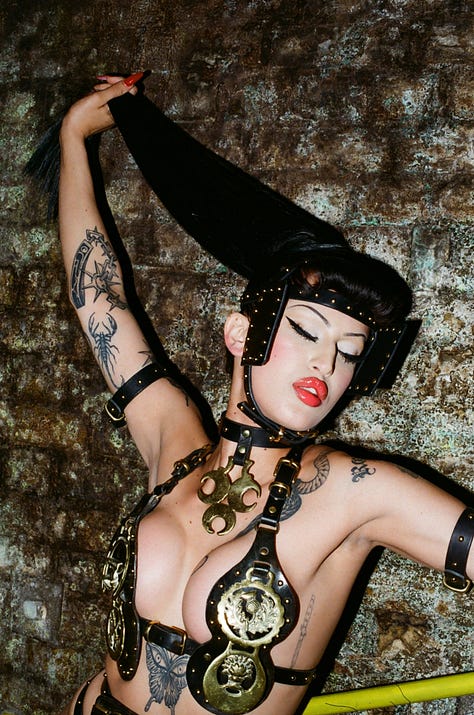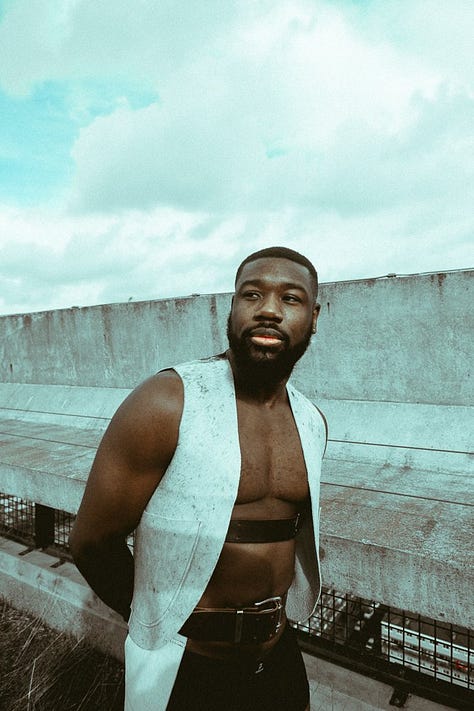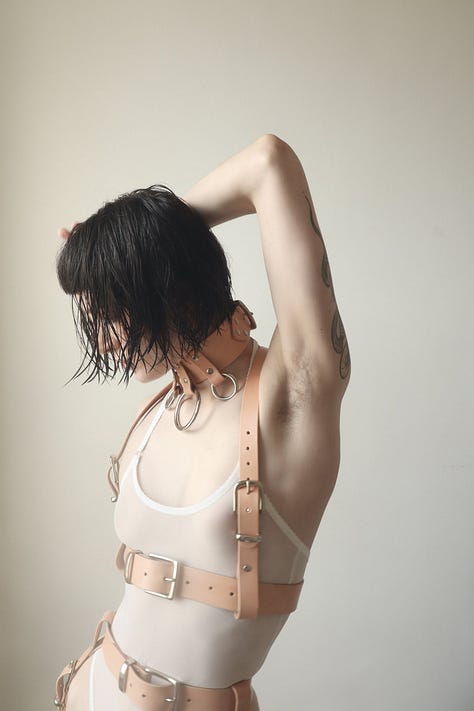Primal Leather sculpts potent, powerful leather armour for every body
From a sculpture degree, to taking inspiration from horse bridalry: inside the making of a cult brand beloved by the kink community and beyond.
Welcome to SHAGGERS, an interview series speaking to creative practitioners expanding sexual culture.
Cast your minds back to 2017. ASOS is churning out plastic, poorly made harnesses as ‘clubwear’. (Ditto for every high street brand you can think of and O-ring collars.) In the summer of this year that I spend some time interning at a leather workshop, surrounded by the smoky, sensual aroma and bearing witness to the sensual, pain-staking process of crafting leather. It’s this experience which has fostered a life-long love of leather and an appreciation for designers who work meaningfully, intentionally with the material.
Coincidentally, 2017 also saw the birth of Primal Leather. Founded by Chloe, a self-described “London Leather Maiden”, the brand works primarily in leather (but has explored latex) and sculpts body adornment for “all humans”. With Chloe studying the interplay of materials and form within an undergraduate Sculpture degree, then spending a stint working behind the counter at Agent Provocateur, leatherwork felt like a tangible, exciting use of the skills the artist had developed so far.
Eight years on, the brand is known for its versatile pieces which skirt the boundaries of fashion and fetish to create something timeless. Below, we hear from Chloe about what makes Primal Leather so unique.
“When I arrive at the studio, the scent of leather hits me as soon as the lift opens.”
Who is behind Primal Leather – and what is your story?
Primal Leather was conceived by me in 2017. I bring in a team of three during busy periods. I’m a sculptor at heart, with a background in fashion design, textiles, and years spent working in luxury lingerie. It’s a pretty overt lens into my long-standing fascination with strapping people, objects – or both – into forms that create a physical conversation between materials, restriction, and the body.
When did Primal Leather begin as a business?
Back in 2017, I was finishing my sculpture degree at UAL (University of the Arts London) and working at Agent Provocateur. I was having daily conversations with clients about their bodies – the wins and the woes – and helping them build visions of themselves that felt more potent, more seen. At the same time, my sculpture practice was all about pushing the limits of structure and restriction.
I knew I wanted to create sensually charged pieces – but I didn’t want to make lingerie. I needed a medium that felt universal in gender and more robust in materiality. Leather was a natural choice – probably also subconsciously because I grew up on a farm and had been exposed to leather being useful. I began deconstructing old bridles and saddles, reworking them into posture collars, harnesses, and bags. I listed a few online and they sold out. It was incredibly affirming to find that there were people who loved reclaimed leather and heavy-duty hardware as much as I did. That was the nudge I needed to keep going.
“To submit to a material that will outlast us is, in a way, to respect it. It offers both strength and solace in its containment. That’s deeply erotic to me.”
How have you developed since you’ve been in business?
From early on we sold pieces internationally – including to 42 American states – which still excites me. I actually think our first order 8 years ago was to Australia. That kind of reach, especially for a niche brand, is something I’m really proud of.
I started in a disused children’s nursery, then moved to working from my home desk. After that, I was commuting two and a half hours to a studio in Woolwich for four years. Recently, we moved into a much larger studio in Zone 1, which felt like a real levelling-up moment.
This past year, I’ve also begun investing back into the business by bringing in people to help with parts of the process. That’s freed me up to focus on growth – and to push things creatively.



What draws you to leather – do you have any connection to the leather fetish scene?
My love affair with leather has deep roots. We’re present in the fetish scene both publicly and privately – so yes, you could say Primal is a congruent brand rather than a fashion fix. I’ve been drawn to the material for as long as I can remember. It’s robust, primal, and beautifully unforgiving – qualities that lend themselves well to the erotic practices of binding, holding, and posture control.
To submit to a material that will outlast us is, in a way, to respect it. It offers both strength and solace in its containment. That’s deeply erotic to me.
“My love affair with leather has deep roots.”
What’s the process of leather work like for you? What are the smells, the textures, the feelings that you associate with this work?
When I arrive at the studio, the scent hits me as soon as the lift opens. It’s the same for our clients when they receive their parcel: they unseal the box, peel back the tissue paper, and inhale.
At Primal, we use thick saddlery leather. That means my hands really have to work to shape it. The surface is often waxy, so there’s a ritualistic aspect to balming it after the piece is finished. The whole process is very physical and erotic, the scent, the resistance, the duality of surfaces on your hands. Our heavy-duty hardware completes the process, it’s the perfect partner for the leather. They collude in the most delicious way.
There’s always a quiet curiosity in the back of my mind about the person who ordered the piece and what they’re hoping to evoke by wearing it. Since Primal defies strict BDSM roles, our pieces can appear dominant or submissive depending on the wearer’s intent. Do you want to clip your tools or be tugged, led astray?
Last year you worked with latex—how was that experience compared to working with leather?
Having studied fashion design, I had an itch I wanted to scratch. I often wore latex with my leather pieces – they felt cohesive – but I couldn’t find latex clothing that suited my taste. I prefer androgynous, baggy silhouettes that I can then bring structure to with leather. I didn’t see that in the market, so I began creating it.
I wanted people to enjoy the slickness of latex without the pressure of the second-skin fit. When we released a few pieces, the response was immediate – people loved them. Orders flooded in. Our clients often wear the latex and leather pieces together, so I’ve never felt like I strayed far from my roots.
You've created items – like the Strapped bag – that nod to fetish/kink but still work in more ‘civilian’ wardrobes. Do you think these pieces connect to a history of kinky flagging?
I wouldn’t say the inspiration comes directly from the fetish or kink - or maybe it weaves it's way subconsciously into everything I make. The Strapped bag came out of a desire to contain one’s belongings inside a kind of contraption. I like that it gives a subtle nod to those who know – but it also challenges ideas of what a “handbag” should be. There’s structure, detail, and hints of bondage in there.
So yes, these pieces do “flag” to an extent. That’s often what draws people to them – they feel safe, but suggestive. And that’s a very compelling place to sit.
“I wanted people to enjoy the slickness of latex without the pressure of the second-skin fit.”
What sort of community has arisen around your work?
Primal has brought a lot of people together. Because our style is distinctive, people often strike up conversations in kink environments after recognising each other’s pieces. Our work is deliberately gender-ambiguous, which has given space to a community of people who feel affirmed in their identity when choosing something from us.
We’ve had clients transition in both directions and treat themselves to Primal as a gift to themselves. Our audience is incredibly broad – different ages, backgrounds, and stories—which I see as a beautiful testament to the ways leather can unite.
How can we support your work?
Invest in us. Buy the pieces. We refer to Primal items as “Lifers” – because the leather will almost certainly outlive us.
We do occasionally get shadow-banned on Instagram, so engaging with our social media really helps. Visibility is currency.






